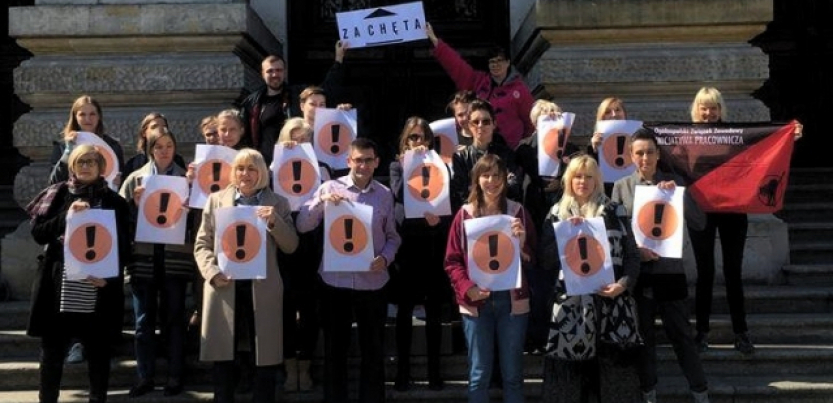by JAKUB GRZEGORCZYK

A general strike in Poland’s education sector that began on Monday, April 8 continues with no end in sight. According to organizers from the two unions that initiated the strike—the Polish Teachers’ Union (ZNP) and the Trade Union Forum (FZZ)—on the first day of the strike 14,000 schools and kindergartens out of 20,400 such institutions joined the walkout. Teachers at 2,000 of those schools have since returned to work, but there are strong indications that this will be a longer protest, comparable in scope to the mobilizations by the country’s teachers between 1991 and 1993.
The strike is occurring with general elections in Poland looming later this year, the first since the right-wing Law and Justice Party’s (PiS) victory in 2015.
ORIGINS: A WAGE DISPUTE
The immediate reason for the strike is that wage bargaining between the two teachers’ unions and the government ended without reaching any results. The education section of the union Solidarno?? (Solidarity) also participated in the negotiations, but—as in other sectors—left the common union front on April 7 and signed the agreement proposed by the government.
ZNP and FZZ demanded a wage increase of 1,000 zloty ($260)—around 30 percent—for everyone employed in education. However, during negotiations both unions declared that they would be willing to sign the agreement if the government agreed to two increases of 15 percent each in 2019. The government’s proposal, agreed to by Solidarno??, included a 5 percent increase in January of this year and a further 9.6 percent in September.
Government spokesperson Beata Szyd?o, Poland’s former prime minister and current vice-chairwoman of the ruling Law and Justice party, also presented a long-term plan for wage increases through 2023, in exchange for an increase in working time spent “in front of the blackboard” from 18 to 24 hours. In addition to putting more work on the backs of existing teachers, the proposal would result in a cut of 20 percent of jobs in the sector. The latter proposal was not even accepted by Solidarno??.
This dispute over wages is a continuation of the conflict between the government and the teachers’ unions that broke out in 2017 over the issue of the education reform. That reform abolished the “gimnazjum”—three years of compulsory junior high school starting at the age 12 or 13, following six years of primary school, with three to four years of secondary school. It reintroduced the system of compulsory primary school lasting eight years followed by four years of high school.
Last year, the monthly basic salary for teaching staff ranged from 2,400 zloty ($630) for apprentice teachers to 3,300 zloty ($867). That’s significantly lower than the average salary in Poland of 4,700 zloty ($1,235). That prompted ZNP and FZZ to put forward an increase of “1,000 zloty for everyone” ($263). When the government refused that demand, the unions began preparing for a strike.
EDUCATION ‘REFORM’
The dispute over low wages might not have been so acute if it had not been for the reform abolishing junior high schools and amendments to the Teacher’s Charter, the equivalent of a collective agreement for the entire sector. Both changes were pushed through by the Minister of National Education, Anna Zalewska.
The 2017 reform was implemented rapidly over the resistance of parents and teachers’ unions. A grassroots citizens’ initiative collected nearly one million signatures in support of a national referendum on the reform, but Parliament ignored the request.
Labor Notes for more